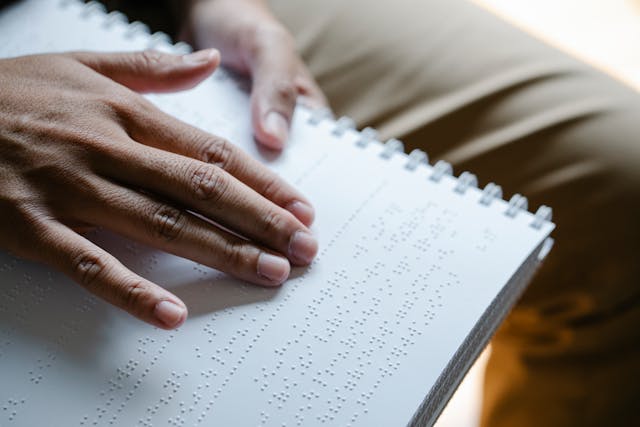
How does braille work? It is a system of writing where you can feel the dots that make up letters and read with your fingers. It is for people who are blind or visually impaired.
It is estimated that there are 43 million blind people and a further 295 million people with moderate to severe vision impairment in the world. That is a very large number. Most education in the world is done through reading and processing the information in textbooks. If someone is unable to read a textbook, it can set back their learning significantly. This can be seen in people with severe dyslexia. A sighted person can always read a textbook to a blind person, but being able to read yourself is a far better way to learn. In the last decade or so, we have had access to smartphones and software to read pretty much any document exists, but this is relatively recentl. Blind people have needed a method to read since the printed word became a thing and braille was invented for that purpose.
Braille was invented in 1824 by Louis Braille. He was French and he had lost his sight at the age of 15. He based his new system on something called “night writing” that had been invented by Charles Barbier in 1815. His system used raised dots to represent the numbers 1 to 5. The alphabet was written in a grid with 1 to 5 on the side and 1 to 5 on the top. It ignored W because not many French words used it. You could write A as 1-1 and Z as 5-5. This was written with dots. The idea was that messages could be read by the army in the dark, without having to use lights and give their position away. He also used a lot of contractions because he realized that most people in the army were not very literate. Braille was aware of this system and he built upon it. Barbier’s shapes were too big and they were too hard to read. Braille decided to make smaller characters and to represent every letter in the alphabet with a symbol made of dots. This became braille. Braille wasn’t actually the first system of writing for blind people, but it was the most simple. Before braille, a system of raised letters had been used. The text was basically embossed into the page. The problem with this is that it was much more expensive to make than braille and it is hard to read. The finger can’t easily tell the difference between some of the letters.
So, how does braille work? Different languages have different versions, so I’m going to look at the English version because it is easiest for me to understand. One braille character has 6 possible dots in two vertical rows of 3. Each letter of the alphabet is represented with a number of dots. For example, A is the top left dot, B is the top left and middle left dot, and R is all three dots on the left and the middle dot on the right. By using this system, all of the letters of the alphabet can be covered without using up all of the dots in the boxes because a six by 2 grid has 64 possible combinations of dots, if you count having no dots as well. The remaining patterns are given to common combinations of letters, such as th, ed, sh, and double letters, like bb, or gg. By doing this, it is possible to shorten words because you can write the character for ch rather than having to write c and then h.
This system of contracting common sounds into one character is continued with common words as well. Because braille characters need to be much larger than written letters, not as many will fit on a page. To make it easier to print and quicker to read, many common words have been shortened to a single letter or to a character. Words like and, but, can, from, you, and many other common words are often shortened to just their first letter or first few letters. This makes it much easier to read.
Braille is read with the pads of the fingers instead of the fingertips because the pads are more sensitive, If you try touching something rough with the tip of your finger and then the pad, you can tell the difference. English braille is read from left to right and most people use the index fingers on both hands to trace the letters. Apparently, the sensitivity to the letters increases with practice. Anyone at any age can learn to read braille, but it is probably easier to learn when young. It can also be read very quickly. The average braille reader can read at 80 to 120 words-per-minute and some people can read at over 200. The average sighted reader only reads at 238 words-per-minute, so there isn’t a great difference. And this is what I learned today.
Photo by Eren Li: https://www.pexels.com/photo/disabled-person-reading-book-with-braille-text-7188870/
Sources
https://www.ncbi.nlm.nih.gov/pmc/articles/PMC4871356
https://www.nature.com/articles/s41433-024-02961-1
https://en.wikipedia.org/wiki/English_Braille
https://en.wikipedia.org/wiki/Braille
https://www.afb.org/blindness-and-low-vision/braille/what-braille
